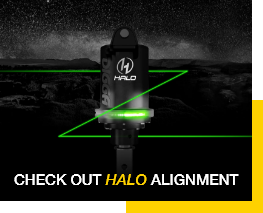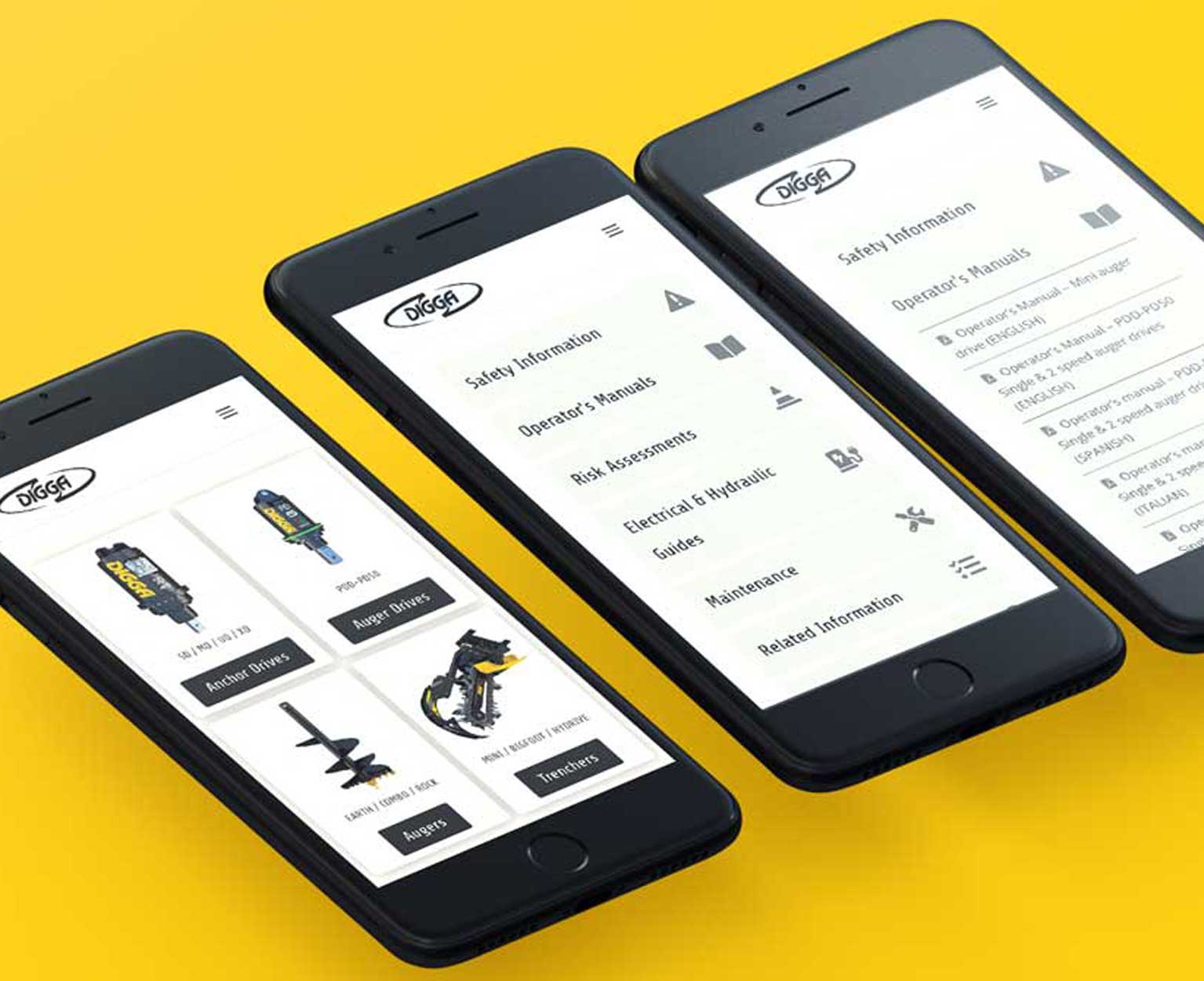INTRODUCTION
Augers
An auger (also known as a ‘drill’ ‘bit’ ‘screw’ ‘pig’s tail’ or ‘drill bit’) is a device designed for moving ground material by means of a rotating auger flight. Augers are made of hardened steel and compromised of a hub, flighting, pipe, boring or cutting head, pilot and teeth. Each auger configuration is optimised for cost and performance according to its intended use.
Hover over the headings below to highlight each part of the auger.
AUGER
Types
Augers come in a wide range of configurations to meet different drilling needs. Please refer to the guide below to learn more. There are advantages and disadvantages to each type which is why the Digga team of experts are here to help you find a fit-for-purpose drilling solution. Call us today.
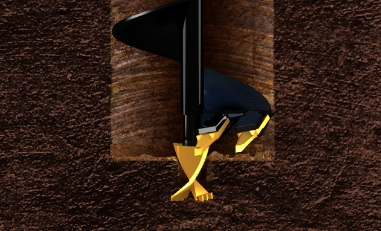
The geometry of the cutting head has been refined over the past 40 years to produce the most efficient augers on the market. Available with 3 different tooth options depending on the ground conditions. Earth teeth (E), flat tungsten carbide (TC) or Multi-Facet Tungsten (MFT)
EARTH AUGER RANGE
GENERAL PURPOSE DRILLING
Tooth Options: Earth, Tungsten Carbide, Multi Facet Tungsten Carbide
Mini Loader
Mini Excavator
Skid Steer
Large Excavator
Backhoe
Tractor
ROCK/COMBO AUGER RANGE
ALL PURPOSE DRILLING
Series Available: RC4, RC6, RC8, RC10
Tooth Options: Multi Facet Tungsten Fixed Pick
Machine Suitability: Up to 20T
Mini Excavator
Skid Steer
Large Excavator
Backhoe
Tractor
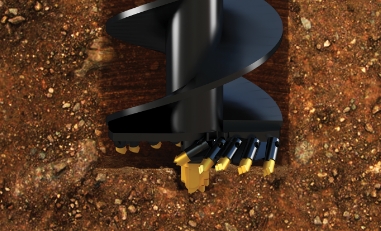
No need to have two augers for different conditions, rock/combo augers are ideal for most drilling conditions – cuts a clean clear hole in earth and shale, and has the ultimate ripping ability in some fracturable rock.
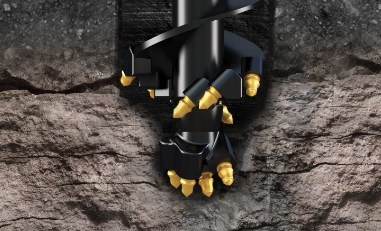
Heavy duty design with high efficiency cutting heads to maximise drilling performance and hard facing for increase durability.
DEDICATED ROCK AUGER RANGE
HEAVY DUTY DRILLING
Ground Conditions: Shale and fracturable rock
Mini Excavator
Skid Steer
Large Excavator
Backhoe
WHAT IS
Tungsten Carbide
Tungsten Carbide provides extended wear life and performance of the Digga auger teeth and pilots. Monotungsten Carbide (WC), or Ditungsten Carbide (W2C), is a chemical compound containing Tungsten and Carbon, similar to Titanium Carbide. Its extreme hardness makes it useful in the manufacture of cutting tools, abrasives and bearings, as a cheaper and more heat-resistant alternative to diamond.
AUGER
Cuts
Auger cut refers to the cutting design of an auger, which contributes to the overall efficiency and effectiveness of the drilling process. Different auger cuts are used for specific applications and materials.
Single Cut
Designed to give less resistance and requires less down pressure from the operator or machine. The flat plate with cutting teeth on one side only on the head plate reduces jamming.
Auger Series:
A1
Ground Conditions:
Soft Earth
Machine Suitablility:
Handheld Post Hole Borers
Finishes Available:
Earth Teeth (E)
Double Cut
Designed to give less resistance and requires less down pressure from the operator or machine. The flat plate with cutting teeth on one side only on the head plate reduces jamming.
Auger Series:
A4 to DR11
Ground Conditions:
All
Machine Suitablility:
Mini Loader to 50t machines
Finishes Available:
Earth (E), Tungsten Carbide (TC) & Multi Facet Tungten (MFT)
AUGER
Teeth
Auger teeth are wearparts made of hardened steel fitted into the pockets of the boring head that provide the cutting/ripping of the ground for the auger. Choosing the correct teeth for the intended use and ground conditions is critical to the overall performance of the auger. As such, Digga auger teeth are grouped into four ranges: TS (Small Bladed/Chisel), TM (Medium Bladed/Chisel), TT (Round Tapered) and Rock Picks (Rotating).
TS Range
TS-1, TS-2, TS-3, TS-C
Auger Compatibility:
TP, A1, A3, A4, A5
Bladed/Chisel Teeth
Ground Conditions:
Suitable for earth, clay, and shale.
Machine Suitablility: Up to 5T
Mini Loader
Mini Excavator
Skid Steer Loader
Finishes Available:
Tungsten Carbide (TC)
Multi-Faceted Tungsten (MFT)
TM Range
TM-1, TM-2, TM-3, TM-C
Auger Compatibility:
A6, A8
Bladed/Chisel Teeth
Ground Conditions:
Machine Suitablility: Up to 24T
Skid Steer Loader
Excavator
Backhoe
Finishes Available:
Tungsten Carbide (TC)
Multi-Faceted Tungsten (MFT)
TT Range
TTD-3
Auger Compatibility:
RC4, RC6, RC8, RC10, RC11
Fixed Tapered Teeth
Ground Conditions:
Drill soft earth and shale; rip into fracturable rock.
Machine Suitablility: Up to 50T
Mini Loader
Mini Excavator
Excavator
Finishes Available:
Multi-Faceted Tungsten (MFT)
Rock Pick Range
DP-8
Auger Compatibility:
DR4, DR6, DR8, DR11
Rotating Rock Picks
Ground Conditions:
Machine Suitablility: Up to 50T
Mini Excavator
Excavator
Skid Steer Loader
Finishes Available:
Hardened Tungsten (HT)
If auger teeth are regularly checked and replaced when worn the auger’s life will be greatly enhanced, machinery will achieve optimal results more easily, and there will be minimal risk of damage to the auger. Pockets and flights on the auger will also last substantially longer. Digga auger wearparts are specially designed to help your auger perform at its best. Our range of auger teeth are designed to suit a variety of ground conditions and uses. Call us to discuss the teeth option which best suits your auger and ground drilling needs.
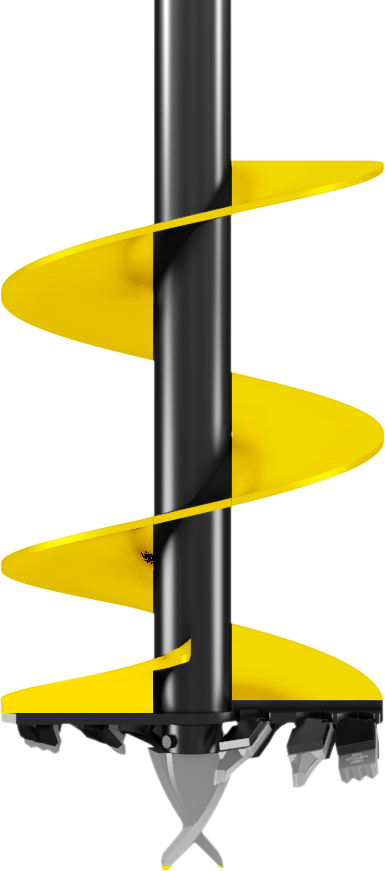
AUGER
Flighting
Auger flighting refers to the circular-shaped steel sections, called ‘pies’, with a central hole and a single division cut that are cut from plate steel of varying thicknesses. The two ends are then pulled or pressed in opposite directions to form helical shapes of varying pitches (distances apart). Auger flighting is fitted to the auger pipe and welded at the join. The auger flights provide the vehicle for moving the spoil/ dirt out of the drilling hole. They are not for the purpose of cutting out the hole.
With the line of sight being the auger’s axis, if clockwise movement of the auger corresponds to axial movement away from the observer, then it is a right-handed helix. If counter- clockwise movement corresponds to axial movement away from the observer, it is a left- handed helix.
Auger flights can be either right-handed or left- handed. A right-handed flight cannot be turned or flipped to look like a left-handed one. The most common augers are right-handed. Typically left handed flights are fitted to truck crane mount or pro-line style augers.
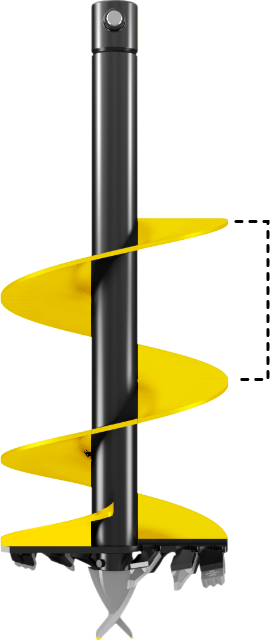
AUGER
Pitch
Auger pitch refers to the distance between corresponding points on consecutive turns of the auger flighting or the distance the conveyed material moves with one revolution of the auger.
Shallow Pitch
On a single flighted auger, the shallower (flatter) the pitch the more spoil it will hold but the slower the lift. In sticky conditions the auger can become hard to clear especially around the cutting head.
Standard Pitch
Digga flights tend to have a medium pitch. All augers up to 8” are single flighted. All augers except A1 are Double Start over 8”. All augers except A1 model, above 450mm (18”) are double flighted on the whole auger.
Steeper Pitch
Digga optimises flight pitch across each auger series to ensure efficient material removal based on the application. Steeper pitch with double flighting is used for handling heavy soils and dense materials, ensuring they are lifted and cleared from the hole quickly. In contrast, shallower, double-start single-carry designs are optimized for lighter, finer materials, improving spoil removal efficiency. Each auger series is designed to perform across various ground conditions, but if you have a special requirement, we can provide a custom solution tailored to your specific soil type or application. Contact our sales team to discuss your needs—they’ll be happy to assist!
Digga pockets are set at a unique angle of 35o-50o to optimise the cutting effectiveness of the teeth.
Double Cut
Boring head has pockets and replaceable teeth fitted to BOTH sides of the cutting head to give all round performance in varying ground conditions.
Single Cut
Boring head has pockets on only ONE side of the cutting head to reduce jamming. Ideally suited for Handheld Post Hole Borers.
AUGER
Boring Head
An auger boring head, also known as an ‘auger bit’ or ‘cutting head’, has a pointed tip and cutting edges that are designed to help drill a precise hole. The boring head consists of a shaped plasma cut steel plate that has pockets, a socket or drive lug welded to the centre of it, and auger teeth which are inserted into the pockets and held in place by a friction devise such as a padlock, rubber or a taper design. A pilot is either inserted into the central socket or placed over the drive lug and held in position with a bolt and lock nut. Digga boring head wearparts are available in a variety of sizes and types. Call us.
AUGER
Pilot
A pilot, much like the pilot of an aeroplane, is the part that controls the drilling of the hole. The pilot starts the position and bites into a smaller radius allowing the teeth to start cutting several mm later.
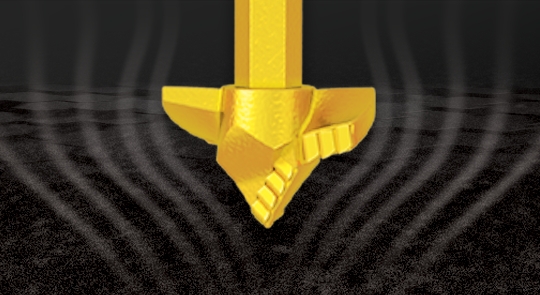
Without a pilot the auger would ‘walk’ away and starting the hole would be difficult without a central holding point. The pilot then keeps breaking the hole from the centre allowing the chisel or bullet style teeth to rip away at the rest of the hole more easily.
With the advent of better cutting head technology, screw-in pilots were replaced with hex fit or square-fit pilots in most cases as screw-in pilots were prone to snap while drilling due to their small diameter threaded shaft. This would leave the broken pilot stuck and impossible to retrieve, causing costly delays and wearpart replacements. As such, Digga’s pilot technology incorporates square, hex and drive lugs as opposed to threads or screws.
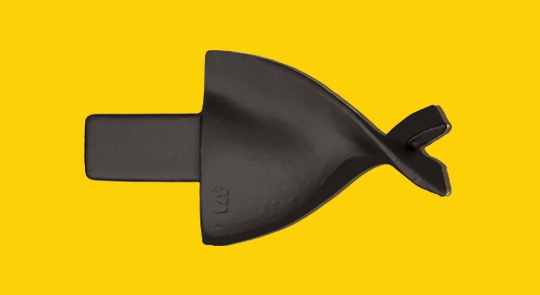
With hex-fit and square-fit pilots, the likelihood of snapping the pilot is nil and if the pilot does become worn or damaged it is simple to change with the removal of a nut and bolt.
PS Pilot Range
PS-1, PS-2, PS-3
Auger Compatibility:
A1, A3
Medium Series
Lug drive pilot
Machine Suitablility: Up to 750kg
Tractor
Finishes Available:
Earth (-1)
Tungsten Carbide (-2)
Multi Facet Tungsten (-3)
PM-SQ Range
PM-SQ-1, PM-SQ-2, PM-SQ-3
Auger Compatibility:
A4
Medium Series
Square drive pilot
Machine Suitablility: Up to 4T
Mini Loader
Mini Excavator
Skid Steer Loader
Backhoe
Finishes Available:
Earth (-1)
Tungsten Carbide (-2)
Multi Facet Tungsten (-3)
PM-HX Range
PM-HX-3
Auger Compatibility:
RC4, A6, RC6, A8
Medium Hex Series
Hex Drive Pilot
Machine Suitablility: Up to 20T
Mini Excavator
Excavator
Skid Steer Loader
Backhoe
Finishes Available:
Multi Facet Tungsten (-3)
PH Range
PH-3, PH-3XL
Auger Compatibility:
RC6, RC8, RC10, RC11
Heavy Duty Hex Series
Hex Drive Pilot
Machine Suitablility: Up to 50T
Excavator
Skid Steer Loader
Backhoe
Finishes Available:
Multi Facet Tungsten (-3)
Extra Long (3XL)
DRP Range
DRP-19-15, DRP-19T, DRP-25T
Auger Compatibility:
DR4, DR6, DR8, DR11
Rotating Pick Series
Hex & Tang Drive Pilots
Machine Suitablility: Up to 50T
Mini Excavator
Excavator
Skid Steer Loader
Backhoe
Finishes Available:
Square drive – 19mm picks
Tang drive – 19mm picks
Tang drive – 25mm picks
HOW TO
Measure the Diameter of an Auger
Knowing the diameter of an auger is important for matching it to the intended use, selecting the right equipment, estimating the amount of material removed, and ensuring safety when drilling near underground utilities or other structures.
AUGER
Sizes
| Auger Series | OAL/Flight Thickness | Standard Size Available | Compatible Wearparts | Compatible Machinery |
|---|---|---|---|---|
| A1 | 960mm / 6mm | 100mm(4') to 325mm(13'') | TS / PS | One Man Post Hole Borer |
| A4TL | 1200mm / 8mm | 100mm(4'') to 900mm(36'') | TS / PM | PDD to PD4 |
| A6 | 1500mm / 8mm | 150mm(6'') to 1200mm(48'') | TM / PM | PD5 to PD10 |
| A8 | 1500mm / 10mm | 200mm(8'') to 1500mm(60'') | TM / PM | PD12 to PD30 |
| Auger Series | OAL/Flight Thickness | Standard Size Available | Compatible Wearparts | Compatible EARTH DRILLS |
|---|---|---|---|---|
| RC4 | 1200mm / 8mm | 150mm(6'') to 900mm(36'') | TT / PM | PDD-PD4 |
| RC6 | 1500mm / 8mm | 150mm(6'') to 1200mm(48'') | TT / PH | PD5-PD10HF |
| RC8 | 1500mm / 10mm | 200mm(8'') to 1500mm(60'') | TT / PH | PD12 to PD25 |
| RC10 | 1500mm / 16mm | 250mm(10'') to 1500mm(60'') | TTD / PH | PD22 TO PD50 |
| RC11 | 1500mm / 16mm | 250mm(10'') to 1500mm(60'') | TTL / PHXL | PD22 TO SD |
| Auger Series | OAL/Flight Thickness | Standard Size Available | Compatible Wearparts | Compatible Machinery |
|---|---|---|---|---|
| DR4 | 1200mm / 10-12mm | 150mm(6'') to 600mm(24'') | 19mm Picks | PDD-PD4 |
| DR6 | 1500mm / 10-16mm | 150mm(6'') to 900mm(36'') | 19mm Picks | PD4 To PD7 |
| DR8 | 2000mm / 16-20mm | 200mm(8'') to 1000mm(40'') | 19mm Picks | PD8HF to PD22 |
| DR11 | 2000mm / 20-25mm | 250mm(10'') to 1500mm(60'') | 25MM Picks | PD25 to SD |
AUGER
Frequently Asked Questions (FAQs)
Do you make an Auger to drill hard rock?
Yes, we manufacture augers that are specifically designed to drill through hard rock. – Dedicated rock augers, Tapered rock augers, Rock Combo augers, Core Barrels, Drilling buckets and custom solutions.
These augers, often referred to as rock augers, or rock drilling tools, have special features that allow them to handle the high levels of wear and tear that come with drilling through hard rock. Some of these features include.
Tungsten Carbide Teeth are designed to be extremely hard and durable, able to withstand the rigors of drilling through hard rock. They can be replaced when they wear out.
Rock augers are typically made with heavy-duty materials that are designed to withstand the high forces and stresses that come with drilling through hard rock. Typically, with addition of hard facing on common wear areas to assist in additional life of the auger.
It's important to note that drilling through very hard rock can be a difficult and time-consuming process and may require the use of specialised drilling equipment, not supplied by Digga like rotary drills or diamond-tipped core drills.
**The ability to drill rock it also very dependent on the host machine size, by fitting a rock auger won’t guarantee you’ll be able to penetrate all rock.
It comes down to the combination down pressure generated from the host machine together with the type of drilling tool and ultimately the MPA (Hardness) of the rock.
For example, a 2t excavator fitted with 450mm dedicated Rock auger, drilling into 250Mpa rock will be unsuccessful, as the down pressures generated from the host machine is not greater than the strength of the rock there for the rock will not fracture meaning the only way to remove the rock will be by grind it away, this will be very time consuming and could use a large amount of wearparts, so in most cases is uneconomical.
What’s the hardest rock I can drill?
The hardness of rock can vary greatly, and different types of rock will require different types of drilling equipment and techniques to drill through. Some of the hardest rocks that can be drilled include:
Granite: Granite is a type of igneous rock that is known for its high density and hardness. It is composed mainly of feldspar and quartz, which are both very hard minerals. Drilling through granite typically requires specialist drill bits and a great deal of time and effort.
Basalt: Basalt is a type of volcanic rock that is also known for its high density and hardness. It is composed mainly of plagioclase feldspar and pyroxene and can be difficult to drill through.
Quartzite: Quartzite is a type of metamorphic rock that is composed mainly of quartz. It is extremely hard and durable, making it difficult to drill through.
Each of these types of rock and with all types of ground conditions they are found in varying forms of hardness the lower the hardness the better chance of drilling it you will have.
As a very general guide and with the right host machine you could expect to see:
- Using a RC auger in the range of ~10 to 80MPa
- Using a DR auger in the range of ~50 to 150MPa
- Using a TR auger in the range of ~50 to 200MPa
- Using a rotating pick Core Barrel in the range of ~50 to 250MPa
- For any rock over ~90Mpa you would typically need a 20t host machine to succeed
It's important to note that drilling through these rocks and other hard materials may require specialized equipment, and also require the use of fluids or coolants to reduce heat and wear on the drill bits.
Additionally, the drilling process may take a longer time and require more effort than drilling through softer materials.
When should I use a tapered rock auger and core barrel?
These types of drilling tools are typically used when the rock being drilled is of high strength or hardness and are additional tools to assist in trying to penetrate the rock.
A tapered rock auger is a type of auger that is specifically designed for drilling through hard rock and other difficult ground conditions. They typically have a tapered design, meaning that the diameter of the auger gradually increases from the centre out until it reached full diameter assisting in creating wear spots in the rock material in an attempt to break or fractur the rock away. Tapered rock augers should be used in situations where the soil or ground is hard, rocky, or otherwise difficult to dig through. They are ideal for drilling through tough materials such as granite, limestone, and basalt, and are also well suited for drilling through mixed soil conditions that include rock or boulders. They are often used in combination with a Dedicated rock auger, whereby the operated alternates between the two tools to achieve penetration. Example: start with Dedicated rock (DR) if you experience refusal, swap out the DR for a Tapered Rock (TR) this should help penetrate the rock, should the TR then get refusal swap back to the DR and continue the process.
It's important to note that tapered rock augers are typically more expensive than standard augers and may also require more powerful equipment to operate. They also may not be appropriate for certain types of projects where the ground is mainly soil or you require a flat base at the bottom of the hole. (you would use the DR to achieve the flatter base)
A core barrel is typically used on very hard rock where a DR or TR auger is getting refusal in theory it achieves penetrating by having less rock to drill away or break up, it cuts a ring around the rock leaving a core in the centre this requires less power and less down force to achieve the downside of this is the ability to break off the core and remove it from the hole. This application is very hard on the auger drive and can generate huge side loads if not done correctly, and wont work in all ground conditions.
Can I put rock teeth on my earth auger?
Yes, if the auger is the A4TL, A6 or A8 series, you can. The Earth cutter (teeth and Pilot) can be removed and replaced with Tungsten Carbide Cutters (teeth and Pilot).
The tungsten carbide cutters come in two types: a TC version which is a flat tungsten carbide tile or the more aggressive MFT which is a Multifaceted tungsten carbide tile.
The MFT and TC Rock wearparts (teeth & Pilot) are designed to help an auger cut through harder, more difficult soils and materials, such as shale, “soft rock” and hardpan sub soils.
They are made utilising tungsten carbide tiles fitted to the tooth body. When fitting these wear parts to the cutting head it improves the augers’ ability to dig through tough materials.
Fitting rock teeth on an earth auger can increase its versatility and allow it to be used in different types of ground conditions, however, it's important to keep in mind that earth augers are typically not as heavy-duty as dedicated rock augers and may not be able to handle the same level of wear and tear that traditional rock augers can.
It's also important to note that when using rock teeth on an earth auger, make sure that the teeth are properly installed and securely fastened, and to regularly check and maintain the teeth to ensure they are in good condition. When drilling in harder ground or rock/rocky ground typically the wear will be extreme when compared to soil drilling.
Consult with the sales or spare parts team for available options and guidance to help you make the best decision.
What size Augers should I buy for fencing?
The auger size needed is dependant on the post size being installed, and the soil conditions you will be working in.
For a standard wooden fence, you may only require a 150mm (6”) or 200mm (8”) diameter auger. These sizes are large enough to accommodate most standard fence posts and provide a stable base for the fence.
If you are installing a chain-link or steel fence, you may want to consider a larger diameter auger, such as a 250mm (10”) or 300mm (12”) diameter. These larger sizes will provide a more stable base for the heavier fence posts and will also make it easier to accommodate larger posts if necessary. Typically, a rural fence using post and rail will use a 300mm (12”) for the post and a 450 (18”) up to 600mm(24”) for the corner or Strainer post.
It's also important to consider the length of the auger, which can range from 900mm (36”) to 1.5m (60”) or more. The length of the auger will depend on the depth of the hole you need to dig and will also be influenced by the soil conditions and the type of fence you are installing.
It's important to consult the fence manufacturers for specifications before deciding. *Always refer to local engineering and building codes for regulations and guidance.
Additionally, consider the power of your equipment and the capacity of your equipment to handle the auger size you choose.
What sets Digga augers apart from the competition?
Digga specialises in manufacturing augers and other attachments for construction and agriculture equipment.
The Digga Auger range has been developed over many years of working directly with our customers along with advanced engineering processes to perfect and optimise our cutting systems to provide the best performance possible, our augers are industry leading for several reasons, such as:
Quality: Digga augers are made with high-quality materials and built to last. We also have strict ISO90001 quality control procedures in place to ensure that each auger meets our standards.
Innovation: Digga have patented features or designs that set their augers apart from those of their competitors. we also invest heavily in research and development to ensure that our products are constantly improving.
Design: Digga’s highly skilled and professional engineering team utilising advanced 3D modelling to ensure the tooth angle and positioning is in the ideal position and angle to give the best cut and penetration ability, and ensure optimum flight pitch to both hold the spoil on the flight for better extraction while getting that spoil to the top of the hole quickly to help avoid auger stall.
Support: At Digga we pride ourselves on our strong customer service and technical support team that can assist customers with any questions or issues they may have with their augers. We offer assistance with choosing the right drilling tool option for your needs.
Versatility: Digga has a wide range of standard augers available together with Bespoke (custom) option to suit different types of projects, jobs, and machinery, coupled with an extensive range of accessories available to expand the capabilities of the auger and auger drive.
Brand reputation: Digga has a strong reputation in the industry for producing high-quality, reliable augers that are known for getting the job done.
It's important to note that different augers are better suited for different tasks and that the best option for you will depend on your specific needs and preferences.
Consult with the sales team for available options and guidance to help you make the best decision.
Do you make custom augers?
Yes, we do, we offer many bespoke drilling solutions.
Consult with the sales team for available options and guidance to help you make the best decision.
When do I need to change my teeth / picks / How long will my teeth last?
The teeth could last 1 or 2 holes or last 100’s of holes, its all dependant on what material is being drilled. Tungsten Carbide teeth/pilots will always out last standard earth teeth/pilots.
The lifespan of an auger tooth depends on a variety of factors, including the type of material it is made from, the type of soil or rock it is used to drill through, and the frequency and intensity of use.
Carbide teeth are known to last longer than steel teeth, due to their high hardness and resistance to wear. A carbide tooth can last for several hundred hours of drilling, depending on the specific type of carbide and the conditions it is being used in.
Steel teeth are generally less durable than carbide teeth and typically wear out faster.
It's important to note that drilling through hard rock, clay or concrete will wear out the teeth faster than drilling through softer soils. Additionally, drilling frequently or for longer periods of time will also decrease the lifespan of the teeth.
Proper maintenance such as regular inspections and replacing worn teeth can also help prolong the lifespan of the auger.
Do you make custom augers?
Yes, we do, we offer many bespoke drilling solutions.
Consult with the sales team for available options and guidance to help you make the best decision.
Still got questions?
We're here to help. Whether you have general enquiries, questions about our product range, want to find your nearest dealer, or are ready to order - contact us today.
 +44 (0) 1488 688 550
+44 (0) 1488 688 550
Call Us
 infouk@digga.com
infouk@digga.com
Email Us
